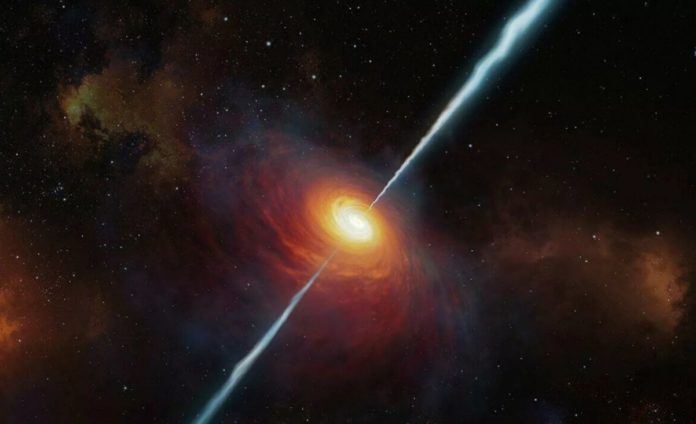Using the European Southern Observatory’s Very Large Telescope (VLT ESO), astronomers have discovered and studied in detail the most distant radio sources known to date, located 13 billion light-years away.
Quasars are very luminous objects located in the centers of some galaxies. According to modern concepts, quasars are active galactic nuclei at the initial stage of development, in which a supermassive black hole absorbs the surrounding matter, forming an accretion disk.
- Scientists in Fear of This New Predator From Red Sea Eating Native Species in Mediterranean
- Does This Mean We Stopped Being Animal and Started Being Human Due to ‘Copy Paste’ Errors?
- The One Lifestyle Choice That Could Reduce Your Heart Disease Risk By More Than 22%
- Aging: This Is What Happens Inside Your Body Right After Exercise
- Immune-Boosting Drink that Mimics Fasting to Reduce Fat – Scientists ‘Were Surprised’ By New Findings
The mechanism of their emission is associated with supermassive black holes located in them. When a black hole interacts with the surrounding gas, enormous energy is released, which allows astronomers to register these objects, despite the huge distances to them.
The article reports on the discovery of the most distant quasar to date, P172 + 18, which emits powerful jets radiation fluxes in the radio range. The light from it came to us for about 13 billion years, and the telescope recorded it as it was when the age of the universe was only 780 million years.
Although more distant quasars are known, astronomers for the first time received clear evidence of the existence of radio jets near a quasar at such an early stage in the history of the universe. About ten percent of quasars have jets – astronomers call them “radio-loud quasar“.
A number of observations with other telescopes and receivers, including the X-shooter detector at ESO VLT, allowed the authors to study more deeply the characteristics of the quasar P172 + 18 – in particular, to determine such key parameters as the mass of a black hole and the rate at which it absorbs the surrounding matter. It turned out that the radiation energy of the quasar is given by a black hole with a mass of about 300 million solar masses, “devouring” huge quantities of gas.
“This black hole very quickly absorbs matter, increasing its mass at a rate inherent in only a very small number of such objects in the Universe,” said Chiara Mazzucchelli, one of the authors of the study, quoted in a press release from the European Southern Observatory.
The authors believe that there is a link between the rapid growth of a supermassive black hole and the presence of powerful radio jets in quasars such as P172 + 18. Apparently, the jets are able to excite gas around the black hole, thereby increasing the rate at which gas falls onto it. This explains how exactly black holes in the early Universe were able to grow to supermassive scales so quickly after the Big Bang.
“I think it’s great to find another building block to understand how the primordial universe works,” says Mazzuccelli.
- Scientists in Fear of This New Predator From Red Sea Eating Native Species in Mediterranean
- Does This Mean We Stopped Being Animal and Started Being Human Due to ‘Copy Paste’ Errors?
- The One Lifestyle Choice That Could Reduce Your Heart Disease Risk By More Than 22%
- Aging: This Is What Happens Inside Your Body Right After Exercise
- Immune-Boosting Drink that Mimics Fasting to Reduce Fat – Scientists ‘Were Surprised’ By New Findings
The researchers are confident that this radio-loud quasar is only the first of many objects of this type, possibly lying at more distant cosmological distances.
“This discovery is encouraging. I hope and believe that the ‘distance record’ we have set will soon be broken,” said another study participant, Eduardo Banados of the Max Planck Institute for Astronomy in Germany.
The results of the study are published in The Astrophysical Journal.
